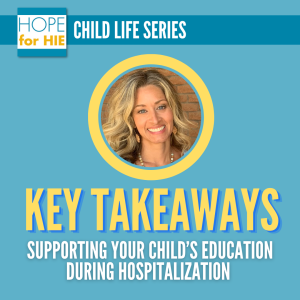
As any parent may attest, there are times throughout the year when supporting your child’s schoolwork can cause stress. After all, when — no — why did they change math? As a parent or caregiver of a medically complex child who may undergo several planned or unplanned hospitalizations, you may know all too well the stress that comes with navigating the demands of schoolwork with the challenges that come with spending a prolonged time in a hospital or at home healing and recovering.
That’s why Annie Gunning, Hope for HIE’s certified child life specialist, recently engaged in a Q&A session aimed at equipping parents with valuable tools, strategies, and resources that will help them, along with educators and hospital staff, support a child’s education for the duration of their hospitalization and to help them transition back into the classroom, post-recovery.
Read on for access to Annie’s expertise and toolbox of resources!

In her role as the Child Life Specialist at Hope for HIE, Annie’s main objective is to help children and families navigate medicalized life. She focuses on empowering and supporting both children and their caregivers, fostering the ability to advocate for their needs while simultaneously reducing stress, pain, and anxiety. This often looks like support for patients and their families facing surgeries, tests, procedures, diagnoses, and hospitalizations by offering preparation, creating personalized coping plans, providing education, fostering creative expression, and incorporating medical play.
If you’re looking to seek the services of a Child Life Specialist in a hospital setting, check with the hospital’s healthcare team! You can reach out to their child life department, pediatric unit, or patient services to inquire about the availability and services provided by a Child Life Specialist, or you can see if your hospital has information on their website regarding the roles and contact details of their dedicated CCLS.

You’re not in this alone: your child’s school and school staff are (and should be) partners in helping you create a reliable, attainable, and coordinated plan for ensuring that your child is still receiving and engaging in a strong learning plan outside of the classroom. Consider these steps to help you formulate that plan:
Recruit a team of relevant staff to help!
After all, your child has a healthcare team, so why shouldn’t they have an educational one, too? This could range from counselors, learning consultants, special education teachers, social workers, and more — all have a unique role to play in supporting you and your child during their prolonged absence:
Create an open line of communication with the teachers, counselors, and support staff.
➡️ If you have advance notice of the hospitalization, request a meeting with your child’s school administrators, teachers, and relevant support staff to share pertinent information about the upcoming medical situation, anticipated duration of absence, and any specific needs your child may have.
➡️ Ensure that you work together to establish a clear line and cadence of communication to eliminate any confusion or miscommunication during their absence.
Establish clear work and learning expectations in advance.
➡️ It’s safe to say that schoolwork is quick to add up, especially if very few accommodations are made to the learning plan. That’s why it’s important to know that learning standards are typically cyclical, meaning that many of them are covered (to a varying degree) across multiple units.
➡️ With that in mind, request that the teacher only focus on assigning material that covers the learning objectives that are specific and unique to that unit. This, of course, varies across teachers, classrooms, and grades, but it is definitely worth discussing. Perhaps that means fewer assignments; perhaps it means the same amount of assignments but with a reduced number of questions, steps, or standards.
Discuss how to foster inclusion and empathy in the classroom and among peers regarding your child’s hospitalization and medical needs.
➡️ Brainstorm together how to help classmates understand your child’s situation, making sure everyone is on the same page when it comes to fostering a supportive atmosphere that’s all about acceptance and kindness.
➡️ This can look different for every child: some may have the ability and willingness to talk to their classmates about their upcoming hospitalization — whether that’s through a rehearsed speech or conversation, a presentation, or an informal talk — while others may prefer a more private approach.

Focusing on all that comes with hospitalization and recovery while also trying to keep up with their education naturally comes with its own set of fears and challenges for children of all ages. Annie has a list of versatile strategies that you can use to help your child navigate these hurdles so they can have a more stable experience despite the unique circumstances of a hospital stay.
COMMON FEARS
POTENTIAL STRATEGIES
We know that hospitalizations don’t just impact the patient; this experience can cause stress for the whole family. For more ways to help your child and the whole family cope with stress, take a look at our previous Child Life Q&A with Annie, in which she explores the ways in which you can help to alleviate some of these tensions through creative expression, play, and other developmentally appropriate strategies.

Parents, caregivers, hospital staff, and child life specialists all have ways in which they can contribute to the success of the patient’s learning plan. While each team member has their own special skill set, Annie wants you to know that a collaborative approach will make this experience more enjoyable, accessible, and successful for all involved.
1️⃣ Find ways to encourage peer connection, whether that’s through small get-togethers with their friends prior to returning to school, or setting up video chats while they are in the hospital or at home recovering. Giving them opportunities to reconnect with their friends or classmates is crucial to decreasing feelings of isolation.
2️⃣ Incorporate play when you can, especially for our younger kiddos. Some parents have had success in feeling identification and expression by encouraging their child to speak through the use of one of their stuffed animals.
3️⃣ Don’t be afraid to advocate for your child’s needs or ask questions about what resources the hospital can provide, whether it’s a quiet space to learn or borrowing technology for schoolwork.
4️⃣ Brainstorm ways to give your child a sense of control. Creating a daily routine chart or calendar and filling in some blanks with “knowns” can help them feel like they have regained some ownership and autonomy over their circumstances.
1️⃣ While in the hospital, a child life specialist can link families and patients to other families/peers with similar situations or stories to better foster empathy and connection.
2️⃣ They can provide outlets and opportunities for children across all ages, impacts, and outcomes to express their emotions, process, learn, and ask questions about their situation. These interactions can alleviate stress and anxiety and result in a more conducive learning environment.
3️⃣ They can refer you to a multitude of resources within that hospital, including a potential in-house school program or teacher. This also includes potential access to an iPad, computer, or quiet learning space to facilitate continued school work. Again, this varies across hospitals, but as the expert of that workplace, the child life specialist will be able to guide you to the right, available resources.
4️⃣ They can also help you and your child create a daily routine chart or calendar. They can help diversify some of the daily slots and activities to include therapies, opportunities for play and connection, school work, meals, and peer interactions.
5️⃣ Child life specialists can also facilitate collaboration with your child’s classroom teacher and peers by offering opportunities for connectedness. One popular strategy that Annie has used for younger patients is “Monkey in my Chair,” in which she works with the patient’s schoolteacher(s) to put a stuffed animal monkey in their seat to act as a tangible symbol of them during their absence. Teachers and classmates can engage with the monkey, write messages, or draw pictures to send to the absent child, fostering a sense of community and support within the classroom.

Navigating the return to school after a prolonged absence can be a significant transition, so Annie has generated some actionable steps that parents, caregivers, and educators can collaboratively take to ensure a smooth and supportive reintegration into the school environment.

Watch the full recording, along with our other Child Life Q&As, on Hope for HIE’s YouTube channel under the Child Life Series playlist, or download our Key Takeaway resource for an at-a-glance look at how to help your kids cope with stress!
Connect with families, read inspiring stories, and get helpful resources delivered right to your inbox.